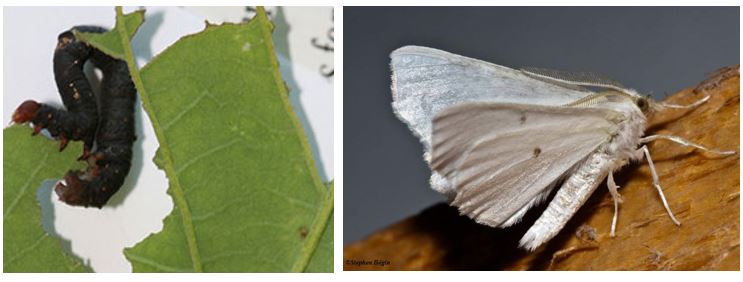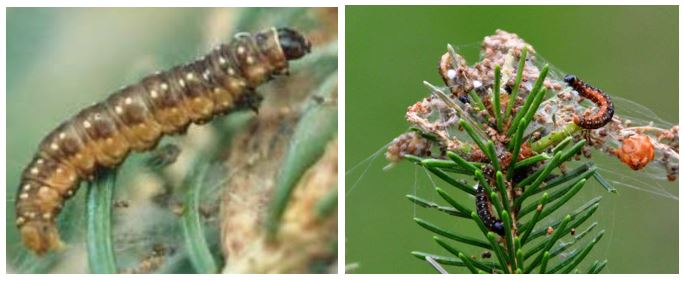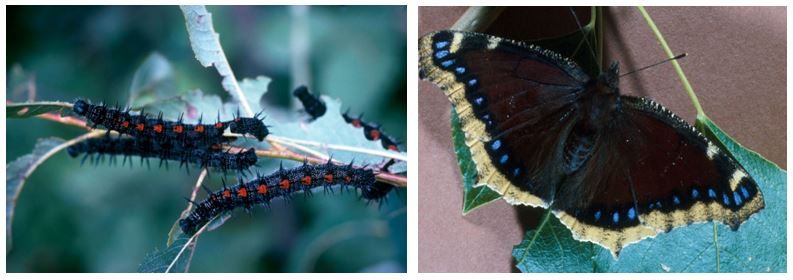Caterpillar Friends and Foes
There are many species of caterpillars in our urban environment. Caterpillars can cause defoliation, which is more of an aesthetic issue. However, a tree already stressed by other factors, such as drought or construction activity, may be put in further decline by insect pests. Our native trees have evolved to turn out a second set of leaves after the caterpillars have finished eating. While caterpillars can be a nuisance in large numbers, they rarely cause long-term damage to trees – some of them turn into inconspicuous moths while others become beautiful butterflies.
Keep reading to get to know the caterpillar friends and foes commonly found in Winnipeg.
Forest Tent Caterpillars
The two species of tent caterpillars most commonly found in Winnipeg are eastern tent and forest tent caterpillars. True to its name, the eastern tent caterpillar may be found in large groups in silken "tents" found in their common host trees: cherry, apple, or maple. The caterpillar is approximately 0.5 cm long with a black head. The body has a long yellow stripe with reddish borders, and the sides are bluish with black spots or bars.
The forest tent caterpillar is the most common in Winnipeg, attacking almost any deciduous tree. The larvae of this caterpillar are distinguished from the eastern tent caterpillar by having pale teardrop shapes running down the middle of its back and more distinguishable blue bands on its sides. Unlike eastern tent caterpillars, forest tent caterpillars do not form tents but tend to huddle together for warmth during cold periods.

Cankerworms
There are two different species of cankerworms in Winnipeg: the spring cankerworm and the fall cankerworm (which is why tree banding is typically done in both seasons). Both species will attack most deciduous trees, with a preference for elm and maple. The female moths of the fall cankerworms lay their eggs after the first severe autumn frost. The spring cankerworm moths lay their eggs after the first spring thaw. The female moths of both species are wingless and must climb up the trunk of their host trees, allowing them to be caught by sticky bands.
The young cankerworm larvae appear as green "inchworms," moving in a "looping" fashion by lifting the front of their body forward and then pulling the rear of their body forward to create the loop shape seen in the photo. The mature cankerworms move in the same fashion but are up to 2.5cm in size. A fall cankerworm is green with a black stripe down its back, and spring cankerworm is mottled dark brown.

Elm Spanworm
The elm spanworm is a significant defoliator of a variety of deciduous trees across Canada. The colour of the caterpillar can range from olive green to brown to black and moves in the same looping fashion as cankerworms. Adult moths are large with white wings and a wingspan stretching about 3-4 cm (1-1.5 in.) wide. During large infestations, homeowners have commented that it looks like "snow in summer", as adult moths can emerge in large numbers.

Spruce Budworm
A common pest for the lumber industry across Canada, this insect can also be found eating the new growth on planted spruce and fir trees in Winnipeg. These caterpillars can be seen in May and appear segmented with a black head. Their overall colour is olive-brown to dark brown with several lighter spots on each of its segments.

Spiny Elm Caterpillar
Despite its threatening appearance, the spiny elm caterpillar is the gorgeous butterfly's larva, the Mourning Cloak. These caterpillars consume the leaves of elm, birch, willow, cottonwood, and hackberry for five to six weeks in a row during the spring and summer. The caterpillars are rarely in great enough numbers to stress their host trees, so insecticides are not usually necessary to keep your tree healthy. The butterfly is one of the few that overwinters as an adult in bark crevices and woodpiles and is one of the first butterflies seen in the spring, emerging as early as mid-April. As an adult, it feeds on oak sap, rotting fruit, and occasionally the nectar of flowers, such as the Shasta daisy.

Treatments for Caterpillars
The caterpillars listed above go through populations cycles – meaning they experience a few years of population growth (where they can become a significant nuisance), followed by several years of decline (where you may not even notice them). Most of our native trees have evolved to cope with caterpillars by putting out a second set of new leaves around late July once the caterpillars have stopped feeding. For the most part, insecticide treatments are usually unnecessary unless you have experienced several years of severe defoliation in a row. In this case, you may want to consider hiring an arborist to apply Btk – a biological pesticide derived from soil bacteria. This product is deemed harmless to other wildlife and people, though it affects all caterpillars, including harmless moths and butterflies.
You can also consider banding your tree with sticky bands or Tanglefoot™ bands in the fall for cankerworm control. This treatment is effective against cankerworms since the females are wingless and have to crawl up the tree to lay eggs. Sticky bands are not effective against other caterpillars, nor do they prevent Dutch elm disease (a common misconception, as we usually see a lot of elms with sticky bands).

